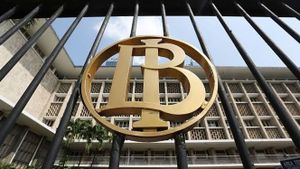JAKARTA - Bank Indonesia (BI) recorded Indonesia's Foreign Debt (ULN) in the third quarter of 2022 has decreased again compared to the second quarter of 2022.
The position of Indonesia's external debt at the end of the period was recorded at 394.6 billion US dollars or equivalent to Rp6,134 trillion ($Rp15,545). Executive Director of the BI Communication Dapertemen Erwin Haryono said the development was caused by a decline in public sector external debt (Pemerintah and Central Bank) as well as the private sector. "In annual terms, the position of the third quarter of 2022 external debt experienced a contraction of 7.0 percent (yoy), deeper than the contraction in the previous quarter of 2.9 percent (yoy)," said Erwin in Jakarta, Tuesday, November 15. Erwin explained that Government external debt in the third quarter of 2022 was still decreasing. The position of Government external debt in that period was 182.3 billion US dollars, lower than the position of external debt in the second quarter of 2022 which amounted to 187.3 billion US dollars. On an annual basis, Government external debt contracted 11.3 percent (yoy), deeper compared to the contraction in the previous quarter which was 8.6 percent (yoy). "The decline in the government's external debt position was due to the transfer of investment in domestic Government Securities (SBN) to other instruments, thereby reducing the portion of ownership of nonresident investors in domestic SBN as uncertainty increased in the global financial market," he explained. Erwin said, the repayment of several program loans and project loans that fell also supported a decrease in Government external debt in the report period. Meanwhile, withdrawal of external debt in the third quarter of 2022 was still prioritized to support government priority spending, including efforts to deal with COVID-19 and the National Economic Recovery (PEN) program. Government's ULN support in meeting priority spending needs in the third quarter of 2022 includes the health and social activities sector (24,6 percent of the total Government external debt), the education services sector (16, defense, and compulsory social guarantee (15,2 percent), the construction sector (14, 2 percent), as well as the financial services and insurance sector (11.6 percent).
"The government's external debt position is relatively safe and under control considering that almost all external debt has a long-term tenor with a share of 99.9 percent of the total government's external debt," he explained. Private Foreign Debt
Meanwhile, the position of private external debt also continued the downward trend. The position of private external debt in the third quarter of 2022 was recorded at USD 204.1 billion, lower than the position in the previous quarter of USD 207.7 billion.
On an annual basis, private external debt contracted 2.6 percent (yoy), deeper than the contraction in the previous quarter which was 0.1 percent (yoy).
Erwin said, the development was caused by contractions in external debt in financial institutions (financial companies) and non-financial companies (non-financial companies) of 4.5 percent (yoy) and 2.1 percent (yoy) respectively, among others, caused by net payments of debt securities.
Based on the sector, Erwin continued, the largest private external debt comes from the financial and insurance services sector; the mining and quarrying sector; the electricity, gas, steam/hot water, and cold air procurement sector; and the manufacturing industry sector with a share of 77.8 percent of the total private external debt.
"The external debt remains dominated by long-term external debt with a share of 75.7 percent of the total private external debt," he said.
BI ensures that Indonesia's external debt structure remains healthy, supported by the application of prudential principles in its management.
Indonesia's external debt in the third quarter of 2022 remained under control, as reflected in the ratio of Indonesia's external debt to Gross Domestic Product (GDP) which was maintained at around 30.1 percent, a decrease compared to the ratio in the previous quarter of 31.8 percent.
In addition, the structure of Indonesia's external debt remains healthy, shown by Indonesia's external debt which remains dominated by long-term external debt, with a share reaching 87.4 percent of the total external debt.
"In order to keep the external debt structure healthy, Bank Indonesia and the Government continue to strengthen coordination in monitoring the development of external debt, supported by the application of prudential principles in its management," said Erwin.
Erwin explained that the role of external debt will also continue to be optimized in supporting development financing and encouraging national economic recovery, by minimizing risks that can affect economic stability.
The English, Chinese, Japanese, Arabic, and French versions are automatically generated by the AI. So there may still be inaccuracies in translating, please always see Indonesian as our main language. (system supported by DigitalSiber.id)












